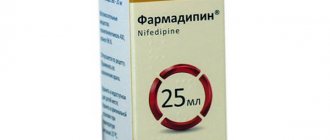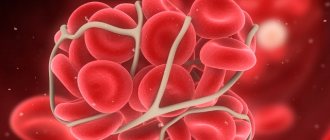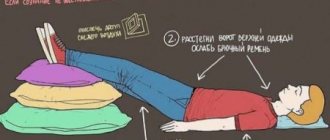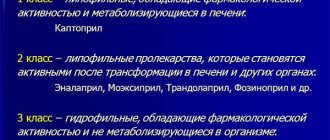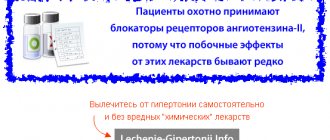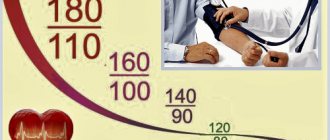- At what pressure can epistaxis be encountered?
- Causes of nosebleeds
- How to stop bleeding on your own?
- What not to do?
- Prevention
Nosebleeds (epistaxis) very often occur due to a sudden change in blood pressure - this is the main cause of this problem. Everyone knows that high blood pressure and epistaxis are closely interrelated, but few are aware that it can appear with low blood pressure.
What are the types of nosebleeds?
Features of anterior and posterior nosebleeds
In medical practice, nosebleeds (epistaxis) are traditionally divided into two types :
- Posterior – bleeding from rupture of large blood vessels (BC) of the distant parts of the nose. Blood runs in a pulsating stream from the nose and flows down the esophagus and can enter the gastrointestinal tract. is not always possible to stop such bleeding without the help of doctors; sometimes the patient is brought to a medical facility.
- Anterior - mild nosebleeds that occur from the breakthrough of thin CS located shallow in the bridge of the nose. Normally, the blood soon clots without active hemostatic measures.
Not frequent and scanty bruises do not require medical attention, but frequent ones with significant blood loss are an alarming sign; they require a medical examination to identify and eliminate their causes.
First aid
If heavy nosebleeds occur, accompanied by a feeling of nausea and dizziness, it is necessary to urgently call an ambulance. If the bleeding from the nasal passage is not too profuse, it is recommended to take the following first aid measures:
- Reassure the patient.
- Open windows or doors to provide fresh air.
- Place the patient in a sitting position on a chair, sofa, or bed and bring a cotton swab treated with ammonia to the nose.
- If you have a first aid kit on hand, make homemade cotton swabs, dip them in hydrogen peroxide and close the bleeding nasal passages. If there is no first aid kit, then you can simply use two fingers to press the nasal passage just above the wings of the nose.
- It is recommended to apply ice or any other product from the freezer to the area where the bridge of the nose is located so that the blood vessels narrow faster and the hemorrhage stops.
In some cases, to stop the hemorrhage, it is enough to simply take a sitting position and lower your head down. It should also be noted that if you have nasal drops on hand, they can also be used to quickly constrict blood vessels and stop bleeding. Instead of drops, natural lemon juice, diluted with water in a 1:1 ratio, is also often used. When lemon juice is instilled into the nasal passage, it has a cauterizing effect, during which a blood clot begins to form in the area of ruptured blood vessels, stopping the flow of blood.
It is very important: when bleeding from the nose, do not throw your head back, as this can provoke a sharp rise in blood pressure and further intensify the process of bleeding.
Causes of nosebleeds
Nosebleeds can be caused by accidental wounds or significant disruptions in the functioning of organs or systems. Anterior bleeding, in many cases, is caused due to injury to the capillary network. Namely:
- Finger wound.
- Bruises (for example, from a fall).
- Powerful nose blowing.
- Impact of a foreign body.
Anatomy of the blood vessels of the nose
An equally common problem is the fragility of the nose from drying out of the mucous membrane. She is provoked by:
- The use of vasoconstrictor drugs for the common cold.
- Allergies.
- Rhinitis, sinusitis, etc. ARVI.
- Dry air.
Posterior bleeding is caused by a number of factors :
- This is high or low blood pressure (BP).
- High intracranial pressure.
- Medicines that can thin the blood .
- The level of vitamins and microelements does not meet the required levels.
- Hormonal problems.
- Fever.
- Stress, lack of sleep, frequent overwork, etc.
Video on the topic:
Prevention
If the bleeding is not caused by injuries to the nose, then this is a sign of vascular weakness, and therefore it needs preventive measures to strengthen it.
To prevent bleeding, there are a number of measures (measures) that have a strengthening effect on the walls of blood vessels:
- harden up, take a contrast shower;
- moderate physical activity (exercise);
- swimming lessons;
- breathing exercises;
- enriching your diet with foods containing large amounts of vitamin C (orange, lemon, currants, sea buckthorn, rose hips, etc.), which helps reduce capillary permeability;
- maintaining a healthy and active lifestyle;
- quitting tobacco and alcohol;
- take vitamins and minerals as prescribed by your doctor, which in addition to strengthening the walls of blood vessels will also improve the functioning of the immune system;
- normalization of diet.
At what pressure does the nose bleed?
If there is bleeding from the nose, what pressure will the tonometer show? There is a misconception that blood flows from the nose only when blood pressure rises. Nosebleeds also occur with low blood pressure and a blood pressure value of 120/80. We can confidently say that pressure and nosebleeds are not always interrelated .
Nosebleeds with low blood pressure
Low blood pressure does not cause nosebleeds. Often these are two consequences of one disease. Possibly, nosebleeds at low pressure occur when hemoglobin is low, and therefore CS are susceptible to fragility, and the blood loses viscosity, which reduces the rate of clotting and increases the likelihood of bleeding.
Hemoglobin norms in women and men depending on age
Hypotension causes dizziness and headaches, fainting is not uncommon, and nasal injuries and concussions that occur along with this provoke bleeding of blood vessels.
If a person suffers from hypotension and nosebleeds frequently, this ailment requires examination at a medical facility.
Nosebleeds due to high blood pressure
Blood from the nose at a pressure higher than usual is the most common type of epistaxis. During a hypertensive crisis, excessively higher than usual pressure is applied to the vascular walls and ruptures occur in them.
If the numbers on the blood pressure monitor reach over 200/100, bleeding from the nose or ears is likely good. It’s bad if the blood has no outlet, it ruptures the veins in the skull and a cerebral hemorrhage occurs (stroke), especially with high intracranial pressure.
With high blood pressure, the risk of vascular bleeding increases :
- With a rapid downward tilt.
- From the summer heat.
- From lifting weights.
- Frequent fatigue and stress or shock.
At normal pressure
Bleeding, at normal pressure, is provoked by a number of factors :
- Insufficient hydration of the mucous membrane.
- Fragility of blood vessels.
- Injury to the vascular walls.
- Allergies.
- Tumor phenomena of the nasal passages.
- Decreased blood clotting.
Ideally, the leaking blood forms a blood clot, like a plug, plugging the hole in the burst vessel. When this does not happen, they talk about poor blood clotting. This is the result of a male hereditary disease - hemophilia or taking medications for varicose veins, thrombosis, etc.
An additional reason for bleeding will be squeezing the nostrils and mouth in order to reduce the noise from sneezing - additional pressure is created that breaks the capillaries of the respiratory tract.
Is this always a problem with hypertension?
With a slight or gradual increase in blood pressure, blood from the nose, as a rule, does not flow. Such a nuisance occurs if there is a rapid pressure drop. This problem can also occur if the capillaries in the nose are too weakened.
Nosebleeds occur as a result of a sudden onset of hypertension, under the influence of a number of unfavorable factors. Moreover, a similar situation occurs not only in hypertensive patients; sometimes the readings on the tonometer can unexpectedly increase in people who do not have this disease.
What factors can contribute to a sharp drop in pressure values:
- A stressful situation is one of the most common phenomena that leads to a sharp increase in blood pressure. Serious psycho-emotional stress can cause hemorrhages from the capillaries in the nose, even in healthy people.
- Also, excessive physical activity often leads to serious hypertension. For example, this situation can be caused by lifting objects that are too heavy.
- Prolonged exposure to extreme heat can also cause hypertension. Prolonged exposure to the sun is especially dangerous.
- Changes in atmospheric parameters also have a strong impact on the body. In this case, an increase in pressure values can cause both an airplane takeoff and an anticyclone.
- Sharp rotations of the head, as well as getting up from a sitting position, can also lead to an increase in the readings on the tonometer.
- Hypertensive crisis is also considered to be the cause of the described situation. With this scenario, the pressure values are so high that the vessels begin to burst.
- Weakening of the walls of the capillaries in the nose under the influence of prolonged hypertension is another reason for such blood loss.
These external and internal factors provoke nasal hemorrhages. Moreover, this problem most often occurs in hypertensive patients, but it can also occur in healthy people.
Nosebleeds during pregnancy
Hormone Levels by Stage of Pregnancy
And during pregnancy, most people experience nosebleeds. This is due to changes in hormonal levels.
Changing levels of certain hormones reduce blood viscosity and increase blood flow, causing nasal capillaries to burst.
An increase in progesterone causes swelling of the mucous membrane of the respiratory organs, congestion in the bridge of the nose and you have to take vasoconstrictor sprays, but they dry out the mucous membrane and capillaries, leading to their fragility.
Many pregnant women have high blood pressure, which increases the risk of bleeding. A lack of a number of vitamins and minerals leads to bleeding of the capillary network of the nose and gums.
The importance of adequate calcium levels in the body
Pregnant women need to eat normally and receive additional multivitamins.
Video on the topic
First aid basics for nosebleeds:
So, if a person with low blood pressure has repeated nosebleeds, it is recommended to undergo an examination, including a complex of biochemical and hematological tests. In addition to the therapist, you should also visit an ENT doctor.
How to beat HYPERTENSION at home?
To get rid of hypertension and cleanse blood vessels, you need.
- Eliminates the causes of pressure disorders
- Normalizes blood pressure within 10 minutes after administration
Bleeding (hemorrhages) is considered the most serious condition in medical practice. One of the most common and relatively safe variants of pathology is nasal (epistaxis) - a nonspecific sign of various diseases. The appearance of blood from the nose is most often recorded after injuries or during a hypertensive crisis (sudden increase in blood pressure). The development mechanism is associated with damage to the integrity or release of elements through the impaired permeability of the vascular wall. However, sometimes this phenomenon occurs against the background of low tonometer values and also requires medical attention.
Blood from a child's nose
Often bleeding in children is caused by the fact that the child himself injured his nose. Children fall and hit their nose repeatedly. They also insert their own fingers and foreign objects into the nostrils, which quickly injure its mucous membrane.
If there is bleeding in the baby's nose, you should check if there are any foreign objects in the nostrils and find out from him whether he inserted something into his nose.
A child bleeds from the nose with high blood pressure, just like an adult periodically at night .
Bleeding of the nasal capillaries in a teenager occurs due to hormonal imbalance and during rapid growth spurts, when the blood supply organs do not keep up with the growing body and the resulting load.
Teenagers need to remember what to do when blood starts to flow and there are no adults with them.
Useful video:
How can hypertensive patients strengthen their nasal vessels?
What should you do if your nose bleeds frequently? Firstly, get examined, discover the real cause of such an illness. Secondly, if it is clear and the doctor tells you that you should start strengthening blood vessels, take these recommendations into account and begin to implement them.
The following actions can be called prevention of epistaxis:
- Rinsing the nasal cavities with a mild saline solution (continuously, you can use sea salt);
- Providing the body with fortified nutrition, possibly a course of dietary supplements and vitamin complexes;
- Carrying out various kinds of stimulating procedures, one of the most accessible is a contrast shower;
- General strengthening physical exercises - exercises, walks, warm-ups, work on exercise machines.
If pressure is the cause of frequent bleeding, it means that you are not taking care of your arterial hypertension enough, are receiving poor treatment, and are not following all the recommendations.
What to do when your nose bleeds?
If you notice blood from the nose, try to get rid of the factors that caused it - remove foreign bodies from the respiratory organs, go into the shade, leave a hot room, calm down, stop physical work.
First aid
Actions to stop bleeding
The algorithm of actions is as follows:
- for a couple of minutes and breathe through your mouth.
- Sit down, slightly bending your head down, or lie (especially for an elderly person) on your side on a pillow.
- Apply a cold object - ice, a container with chilled liquid, a lump of snow, a compress from a wet napkin.
- Give yourself a breath of fresh air; if it’s hot, turn on the air conditioning.
- To stop bleeding, use hydrogen peroxide and cotton gauze.
- If only one nostril , drop cold drops into the other, they will narrow the capillaries, reducing blood loss.
- Call an ambulance if the bleeding does not stop after a quarter of an hour , you feel a headache, nausea, confusion, fainting, etc.
If there is no chronic hypertension or hypotension, then determining whether the pressure is high or low is necessary only with a tonometer; you cannot take medications at random; such treatment can significantly worsen the condition.
| Signs of hypotension | Signs of hypertension |
| Dizziness | Pain in the back of the head, temples |
| Headache | Nausea, vomiting |
| Apathy | Bright flashes before the eyes |
| Fainting | Increased heart rate |
With high blood pressure
Nosebleeds with high blood pressure should not be stopped immediately - a small loss of blood will reduce the pressure and prevent a stroke.
Please note what to do if you have high blood pressure
If blood pressure rises above 160/100 mm. rt. Art. you need to take a blood pressure-lowering medicine; in case of chronic hypertension, you must always carry these with you and remember at what blood pressure you cannot do without them.
You also need to ensure peace, apply warmth to your feet, and wrap them in a blanket. If you notice that your blood pressure fluctuates frequently , contact the clinic and get a diagnosis.
At low pressure
In case of low blood pressure, it is necessary to promptly use medicinal substances to raise it; espresso, strong teas or other drinks containing caffeine are offered.
After stopping the bleeding, it is useful to walk and perform light exercises.
Wrong actions
Doing the wrong thing during a nosebleed can make it worse. Therefore, it is good to clearly know what not to do in such situations:
Throwing your head back strains the cervical vertebrae, and the blood does not come out, but flows into the throat. In addition, with low pressure, there is a high risk of loss of consciousness, and with this position of the head, if you fall, you are guaranteed to be injured. Rinse your nose with water, especially if you are not sure of its quality. Firstly, this will prevent the blood from clotting, and it will still flow. And secondly, by drawing in water through your nose and then blowing it out, you activate the work of the capillaries, increasing bleeding. Blow blood from your nose. This way you can blow out blood clots that have already formed to clog damaged blood vessels. Apply vasoconstrictor drugs and other drops into the nose. No medications will work in this situation, since the flowing blood will simply wash them out of the nose. A sharp narrowing of blood vessels will only increase bleeding. Change tampons often or keep them on for a long time. They are administered for a maximum of 15 minutes. During this time, the blood has time to clot, and the mucous membrane is not seriously injured. After removing the tampons, you just need to sit quietly for 10-15 minutes, trying to breathe through your mouth and not your nose.
For at least 2-3 hours after the nosebleed has stopped, it is necessary to refrain from hot (and especially strong!) drinks, coffee and strong tea, smoking, and intense physical activity. However, all this is contraindicated for people suffering from hypotension or hypertension.
It is important to understand that stopping nosebleeds and even improving blood pressure is not too much of a problem. And if such situations happen rarely, you just need to not panic, but understand how to act correctly.
But when a problem occurs regularly, it is necessary not to take temporary measures, but to eliminate the cause. And this can only be done in collaboration with a doctor.
What should you not do to stop a nosebleed?
Please note what not to do and why
- You cannot throw the back of your head up, or lie on your back - this will cause the flow of blood to enter the esophagus, descending to the stomach, it can provoke vomiting; for the same reason, do not swallow blood - flowing down to the bronchi, it causes a cough.
- You should not make sudden movements - such actions will increase blood pressure and blood loss.
- You should not blow your nose - this will further injure the blood vessels.
- It is not recommended to rinse your nose with water - it prevents blood clotting.
Recommended viewing:
Is it possible to prevent this condition and how to do it?
The occurrence of bleeding against the background of low pressure is most often a sign of concomitant pathology. You can prevent the development of epistaxis:
- treatment of the underlying disease (depending on the pathology - hormonal therapy, blood products, cytostatics and other drugs as prescribed by the doctor);
- strengthening the vascular wall with vitamin preparations (for example, Ascorutin - a complex of vitamins C and P);
- balanced diet with sufficient levels of microelements and vitamins;
- regular physical activity, which increases the tone of the smooth muscle cells of the vascular wall;
- use humidifiers, since overdrying of the mucous membrane promotes the development of bleeding.
Nasal hemorrhages often occur in patients who take blood thinning drugs (Aspirin, Clopidogrel, Warfarin and others). To prevent the development of pathology, the use of products should be carried out only according to indications with the permission of a doctor.
The development of nosebleeds against the background of low pressure is a sign of failure of the cellular composition of the blood, the coagulation system, or pathology of the vascular wall. A distinctive feature from hypertensive epistaxis is the absence of a tendency to self-destruct due to reduced vascular tone. Timely provision of assistance prevents the development of massive blood loss, however, frequent episodes of hemorrhage require consultation and thorough examination by a doctor.
Preventive actions
Prevention of bleeding is aimed at eliminating the causes of epistaxis. Dosed physical activity and a nutritious diet containing sufficient amounts of microelements and vitamins support vascular health and reduce the risk of blood pressure surges. It is also necessary to promptly treat chronic diseases.
It is necessary to regularly ventilate living and working areas and use a humidifier to prevent dryness in the respiratory system. At home , in addition to a humidifier, a moistened sheet on a radiator will help.
In order to prevent nosebleeds in children, do not leave them unattended by adults, monitor the integrity of toys, store small, piercing and cutting objects in inaccessible places.
Blood pressure and nosebleeds are not always related . In some cases, they pass quickly and do not require the help of a doctor. But calling an ambulance is necessary if blood flows for more than 15 minutes or if blood clotting is known to occur.
Noticing regular and large blood loss requires a comprehensive medical examination .
Symptoms of hypertension
Blood from the nose due to pressure occurs when this value reaches sufficiently high limits. This suggests that either the body is affected by serious negative factors, or hypertension is at a fairly advanced stage.
High blood pressure cannot be ignored. If such a problem arises, then it must be eliminated with the help of antihypertensive drugs. However, before you start taking any medications, you need to consult a doctor to clarify the diagnosis.
A number of characteristic symptoms will help you suspect that your nose is bleeding due to high blood pressure. If they occur, you should use a tonometer to confirm the correctness of your conclusions.
Symptoms of hypertension:
- A person's skin turns red. Especially the face, neck and chest.
- There is a feeling of dizziness and pain in the head area.
- Symptoms of hyperhidrosis are usually observed.
- Noise, crackling and rustling in the ears are another symptom of hypertension.
- Temporary visual impairment is also observed. “Dots” float before your eyes, and objects become less clear.
- In addition, there is a strong feeling of nausea. In some cases, vomiting may even occur.
- Heart rate increases.
- The patient experiences increased irritability.
These symptoms indicate increased blood pressure. However, if some of them occur, you should not immediately take antihypertensive drugs. After all, the symptoms of hypertension are very similar to the signs of hypotension. And taking the wrong remedy can only make the situation worse. Therefore, you first need to measure the pressure values using a tonometer.
If bleeding is caused by hypertension, you should contact a healthcare professional. After all, hypertension poses a significant threat to the body. It can cause heart attacks, hypertensive crises, strokes, as well as pathologies of the liver, heart muscle, kidneys and many other organs.

